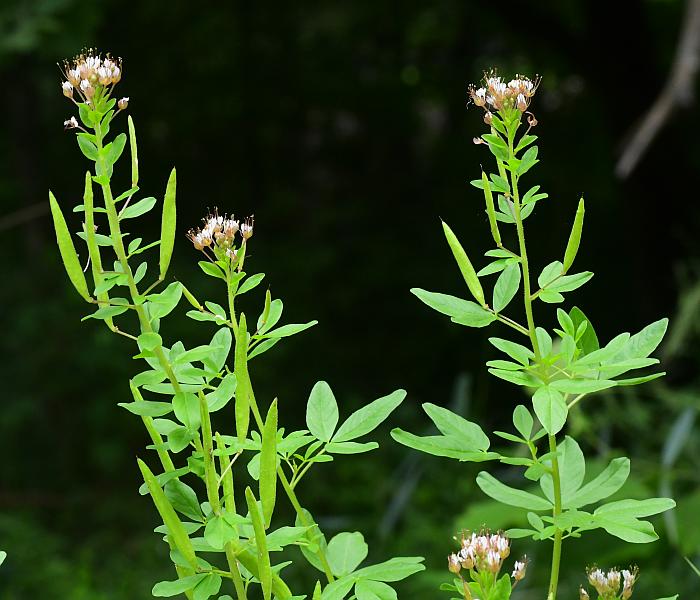Polanisia dodecandra (L.) DC.
Clammy-Weed

Native
CC = Amb
CW = 5
MOC = 58
© SRTurner
Polanisia dodecandra (L.) DC.Clammy-Weed | |
 |
Native CC = Amb CW = 5 MOC = 58 |
© SRTurner |
|
Family - Cleomaceae Habit - Taprooted annual forb. Plants pubescent with dense, minute, spreading glandular hairs and longer, matted, often gland-tipped hairs, usually with a characteristic odor when bruised or crushed, sticky to the touch. Stems - Erect, to 60 cm, sparsely to moderately branched, glandular-pubescent.
Leaves - Alternate, trifoliate, petiolate. Petioles 1-6 cm long, sometimes nearly lacking, glandular-pubescent. Stipules hairlike, inconspicuous, 0.2-0.9 mm long, withering quickly as the leaves mature and often visible only on very young growth. Leaf blades trifoliate, the leaflets 0.8-6.0 cm long, ovate to oblanceolate, narrowed or tapered at the base, rounded or bluntly to less commonly sharply pointed at the tip, the margins entire.
Inflorescence - Terminal and lateral bracteate racemes to 20 cm, sparsely flowered to more commonly relatively dense. Bracts 0.8-1.5 cm long, 2-5 mm wide, simple, mostly short-stalked, lanceolate-elliptic to narrowly elliptic.
Flowers - Zygomorphic with unequal petals, the stalks 1.0-2.5 cm long. Sepals 2-7 mm long, 1.4-2.4 mm wide, lanceolate to obovate, fused at the base. Petals 4, 4-10 mm long, clawed, the lower pair longer than the upper pair, spatulate, narrowed to a stalklike base 2-5 mm long, the tip shallowly and broadly notched (occasionally the shorter pair merely truncate at the tip), white with a pink to purple basal portion. Gland an oblique truncate mass, 1-2 mm long, fleshy. Stamens 8-20, the filaments 5-20 mm long, unequal in length with staggered maturation, the anthers 0.8-1.4 mm long, narrowly elliptic, attached above the base. Gynophore short at flowering (0.2-0.8 cm), not elongating as the fruit matures. Pistil of 2 fused carpels, 1-locular, the placentation parietal. Style 1, often very short and inconspicuous, the stigma capitate or a somewhat concave disc, often shallowly 2-lobed.
Fruits - Capsules, strongly ascending to erect, 2-6 cm long, 4-10 mm wide, not constricted between seeds, dehiscing from the tip, the 2 valves tending to persist and the fruit thus shedding the seeds tardily by shaking in the wind. Seeds numerous, more or less circular in outline, usually somewhat flattened, appearing folded or curled, 2.2-2.4 mm in diameter, the surface minutely and inconspicuously wrinkled or pebbled, dark brown to reddish brown.
Flowering - May - October. Habitat - Streambanks, gravel bars, glades, ledges and tops of bluffs, sand prairies, railroads, roadsides, open disturbed areas. Origin - Native to the U.S. Lookalikes - Distantly, species of Cleome. Other info - This species can be found scattered throughout most of Missouri, most commonly in the southern half of the state. It occurs coast to coast across the continental U.S, though rare to absent in the extreme northwest and southeastern portions of the country. The plant is easy to identify from its viscid stems and fruits, small white flowers, and three-lobed leaves. Bruised foliage emits a highly distinctive odor reminiscent of bell peppers. The plant is highly variable in size. Two subspecies are commonly recognized in Missouri, based on flower size. The more common is spp. dodecandra, which has flower petals 4-6 mm long and fruits 2.5-5.0 cm long. This is the form pictured above. Less common is ssp. trachysperma, which has petals twice as large and fruits 4-6 cm long. A third subspecies, ssp. riograndensis, is found in the southern tip of Texas. The species is closely related to the often-cultivated Cleome, to which it bears some resemblance. The genus was formerly placed in the family Capparaceae (caper family). Both Capparaceae and Cleomaceae families are closely allied with the mustards (Brassicaceae). Photographs taken at Logan Creek, Reynolds County, MO., 7-6-03, and at Big Spring Park, MO., 7-6-04 (DETenaglia); also along Fox Creek, St. Louis County, MO, 7-29-2020 and 9-2-2020 (SRTurner). |